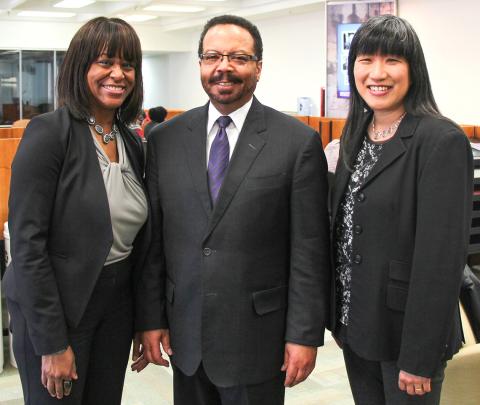Practice Makes Perfect
Physicians Can Train Like Elite Athletes, Pugh Says

Photo: Raymond Macdougall
Elite athletes perfect their “A” game with electronic feedback they and their coaches may analyze of swim strokes, golf swings and numerous other motions and behaviors. Dr. Carla Pugh, guest speaker at a recent NIH Director’s Wednesday Afternoon Lecture, recognized early in her medical career that, like athletes, physicians could benefit from the data obtained with sensors and motor tracking devices to learn and improve their technique. Pugh is the Susan Behrens professor of surgical education and vice-chair of education and patient safety at the University of Wisconsin.
As a high school athlete in swimming, track and softball, Pugh recalls feedback she received after every match. By contrast, after medical school and a surgical residency, she found that the concept of feedback got left behind. She returned to the classroom for a Ph.D. in education, including coursework in human-computer interactions, motivated by the question: How can we get the data such that no surgeon in training or in the clinic would ever practice their craft without getting continuous feedback on how they might improve?
In 17 years of research, the past 10 as an NIH grantee, Pugh has designed simulators with sensors and detectors that provide an objective assessment—through data—of medical skills. Clinicians in training and seasoned experts alike have lined up to use her simulators, contributing valuable performance data and gaining elusive feedback.
Pugh provided an overview of the evolution of her use of simulators in medical training. Her first, in 2000, was built with medical mannequins outfitted with basic direct-force sensors to record touch and pressure delivered in a simulated gynecologic exam. Medical students performing simulated exams appeared competent, but the sensors and computer interface revealed quite different touch and pressure readings that guided further instruction for each student. “That’s when I knew there was something huge here—something we could potentially do with this data,” Pugh said.
She expanded the simulator study to include 700 expert clinicians in obstetrics and gynecology. By comparison, experts completed the simulated exam in half the time and with less pressure and greater accuracy. That predictable result was accompanied by the surprise effect of experts lining up to participate so they could receive the feedback provided by the simulation.
The laboratory’s lineup of simulators soon included a digital rectal exam, which revealed valuable training information. “It was quite interesting to see the students looking at the computer while learning the exam and autocorrecting, without needing feedback from a faculty member,” Pugh said. “One of the things that we discovered is that there is a lot lost in translation when the students go from reading what they’re supposed to do in a textbook and actually trying to do it.” Her team received an award for the work in 2008 from the Association for Surgical Education.
“I began to instrument any simulator I could get my hands on,” Pugh said, describing the intubation simulator. The tricky procedure is performed for surgeries as well as to establish an airway for a patient during an emergency. “We put sensors in places where you should be touching and where the instruments should touch, and we put them in places where you shouldn’t.” The data showed that an experienced doctor could place an intubation tube in 12 seconds with fewer wrong moves than a novice committed in 30 seconds.
Breast exam simulation followed. “It’s actually kind of complex; everyone does it differently,” Pugh said. In 2011, Pugh’s breast exam project, supported by the National Institute of Biomedical Imaging and Bioengineering, earned her a Presidential Early Career Award for Scientists and Engineers.
The breast exam simulator represents a significant advance from Pugh’s early simulators. Sensors in the device can detect directional force; her team videotaped each simulation to be synched with force and directional data. This simulation study showed that 15 percent of physicians who participated with an average of 20 years in practice do not apply enough force to find a lesion in a breast exam. More than half didn’t practice the recommended linear strip palpation that achieves greatest tissue coverage.
Pugh’s ongoing projects extend to operating room procedures, from sutures to laparoscopy. She collaborates with experts to differentiate data signals for various types of touch and with data scientists to extract the many performance variables from her data.
“There is an endless supply of sensor data and new technologies that we can try in the operating room,” Pugh said. “The simulator is my bench, my mouse. I can have different simulators, but it’s the data that is helping move this agenda and the science forward.”
